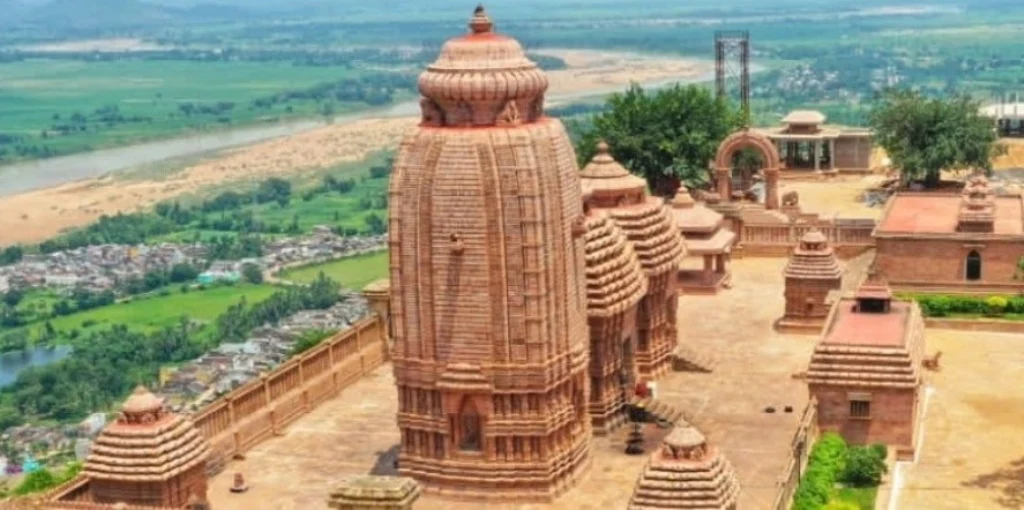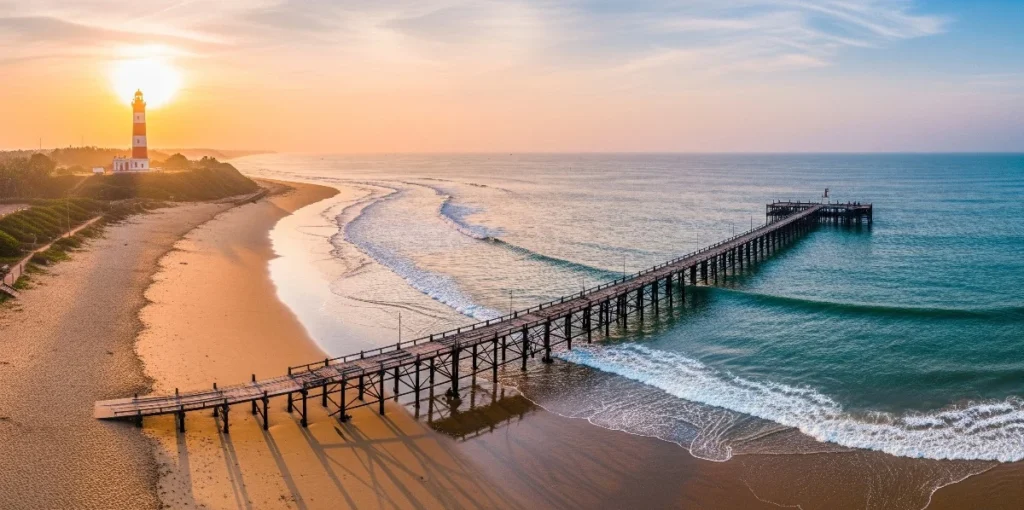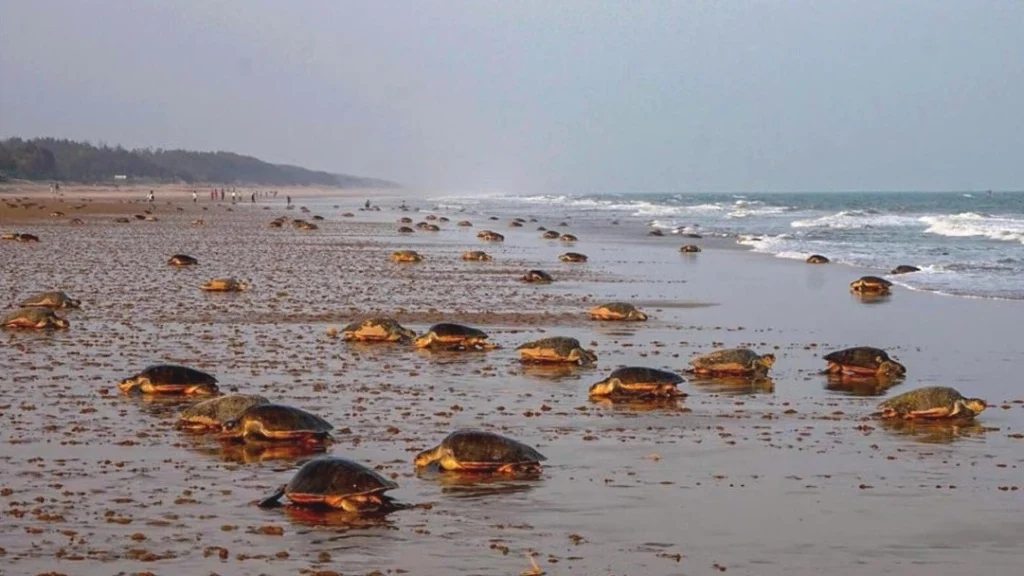Tara Tarini Temple is not just a spiritual destination—it is an experience that transforms you. Located in the serene Kumari hills on the bank of Rushikulya river near Purushottampur in Ganjam district of Odisha. This ancient Shakti Peetha is dedicated to the twin goddesses Tara and Tarini.
This ancient Temple captivates seekers, travelers, and history enthusiasts with its breathtaking views and soul-touching rituals. As I climbed the steps toward the shrine on a breezy morning, I felt a powerful energy surrounding me—one that seemed to whisper ancient stories from the past.
Mythological Background: The Sacred Sisters of Power
According to the Hindu Puranas, Sati, the daughter of Prajapati Daksha, married Shiva against her father’s wishes. Daksha performed a grand yajna (sacrifice) but did not invite Sati or Shiva. Even so, Sati went to the yajna, where Daksha ignored her and insulted Shiva. Unable to bear the insult, Sati offered herself into the fire. Filled with grief, Shiva wandered the universe carrying her half-burnt body. At last, Vishnu used his Sudarshan Chakra to cut her body into 51 parts, which fell on different places across the earth. Each of these places became a Shakti Peeth.
Her breasts are believed to have fallen on the Kumari hills, where the Tara Tarini Temple now stands. It is one of the four Adi Shaktipeethas alongside Vimala, Kamakhya and Kalighat.
The twin goddesses, Tara and Tarini, embody the divine power of Shakti. Devotees worship them as eternal protectors who symbolize strength, compassion, and the nurturing essence of motherhood. As a result, the temple holds deep mythological significance, making it a powerful place of worship—especially for those seeking blessings of prosperity, fertility, and protection.
Historical Background: A Temple Through the Ages
The roots of the temple trace back to the ancient Kalinga period. Historical accounts describe Tara Tarini as the Ista Devi (presiding deity) of the Kalinga kings. Ancient texts mention the temple, and archaeological finds confirm its existence since the 7th century.
Over time, rulers like the Ganga dynasty, especially King Anantavarman Chodaganga Dev, expanded and promoted it. The temple thrived during the medieval era as a major center for Shakti worship. Even today, its rituals reflect a harmonious blend of past and present traditions.
Architecture: Simplicity Meets Spiritual Grandeur
Built in the traditional Kalinga style, the architecture of Tara Tarini Temple is both simple and majestic. The main shrine houses stone idols of Tara and Tarini, adorned with silver ornaments and colorful silk sarees.
The temple complex is structured with intricately carved stone pillars, sloped roofs, and mandapas for rituals. The sanctum radiates a sense of purity. Although the architecture does not boast excessive grandeur, it touches visitors with its spiritual essence and timeless beauty.
One of the most fascinating aspects of the temple is its 999 steps, which many devotees climb barefoot as a mark of deep devotion. Alternatively, visitors can choose to take the ropeway or drive up the hill, making the journey accessible to all.
Geographical Location of Tara Tarini Temple

Tara Tarini Temple sits gracefully atop the Kumari Hills, near the banks of the River Rushikulya in Ganjam district, Odisha. Located about 30 kilometers from Berhampur city, the temple offers a panoramic view of lush forests, winding rivers, and scattered villages.
The elevated position of the temple not only offers scenic beauty but also symbolizes spiritual ascent. The physical climb mirrors the internal journey of rising above the mundane to connect with the divine.
How to Reach Tara Tarini Temple
Getting to Tara Tarini Temple is quite convenient. If you are traveling by train, the nearest station is Berhampur, which is well-connected to major Indian cities. From there, taxis and local buses are easily available.
Nearest Airport: Biju Patnaik International Airport in Bhubaneswar is the closest, which is around 180 kilometers away. A smooth road journey from Bhubaneswar to the temple takes about 4–5 hours.
If you’re a nature lover or an adventure seeker, climbing the 999 steps can be a fulfilling experience. For others, the ropeway offers a thrilling aerial view of the surrounding landscape.
Where to Stay
Tara Tarini Temple has a variety of stay options nearby to suit different budgets. The closest city, Berhampur, offers several hotels ranging from budget lodges to mid-range and premium accommodations. For those who prefer staying closer to the temple, a few guesthouses and dharamshalas are available near the base of the Kumari Hills.
During my visit, I chose to stay at Hotel Nirupama, a well-maintained property offering both comfort and proximity to the temple. What impressed me most was the serene environment—early mornings were filled with the sound of temple bells, chirping birds, and devotional songs drifting from nearby shrines. The hotel staff was courteous, and the rooms were spacious, clean, and perfect for a peaceful retreat.
Best Time to Visit Tara Tarini Temple
Although the temple welcomes visitors throughout the year, the best time to visit Tara Tarini Temple is during the Chaitra Mela, held in March–April. This vibrant and month-long festival draws thousands of devotees from far and wide. Notably, Tuesdays during this period are considered especially auspicious, adding to the spiritual energy of the celebrations.
Winter, from October to February, also offers a pleasant time to visit, as the cool weather enhances the overall experience. Especially during early mornings, the clear skies and tranquil surroundings create the perfect atmosphere for meditation and quiet reflection.
Local People and Culture
The people of Ganjam district are known for their warmth, hospitality, and deep-rooted spiritual beliefs. Most of them speak Odia, though you’ll find people communicating in Hindi and English as well.
Villagers often participate in temple rituals and cultural activities with genuine devotion. The local economy thrives on temple tourism, with many small shops selling flowers, coconuts, and handcrafted souvenirs.
The region is also rich in folk traditions, with music and dance often forming a part of temple festivities. You’ll be moved by the simplicity and sincerity in the eyes of locals who live with the temple as an integral part of their daily lives.
Nearby Places of Attraction: Exploring More Than the Divine
Your trip to Tara Tarini Temple can easily be extended to explore nearby attractions:
Gopalpur-on-Sea

Just 45 km away, this beach town offers tranquility, seafood, and stunning sunsets. Gopalpur‑on‑Sea is a laid-back coastal town in Ganjam district, once a bustling seaport during the Kalinga and British eras, now rediscovered as a tranquil beach retreat. Palm Beach Resort, built in 1914 by an Italian and later acquired by The Oberoi Group in 1948, is Odisha’s first modern beach hotel. The annual Gopalpur Beach Festival, hosted since 1996 in December by the Ganjam District Hotel Association, features sand sculptures, local performances, and cultural showcases
Chilika Lake
A little over 100 km from the temple, it is Asia’s largest brackish water lagoon, famous for migratory birds and dolphin sightings. A designated Ramsar Wetland of International Importance since 1981, Chilika was once listed on the Montreux Record for ecological degradation, but restoration efforts by the Chilika Development Authority (CDA) led to its removal in 2002. The peak season is November to February/March, when migratory birds arrive, weather remains pleasant (~4–22 °C), and dolphin sightings are optimal.
Berhampur City
Berhampur, Odisha’s southern gateway, derives its nickname due to the renowned Berhampuri Patta sarees—handwoven silk made by the Dera weaver community who migrated here in the 17th century. Ancient-era Berhampur prospered as part of the Kalinga empire, with nearby sites like Jaugada (Samapa) serving as strategic centers during Mauryan and Eastern Ganga rule. Thakurani Yatra (also Buddhi Thakurani Jatra) is Berhampur’s signature biennial festival (March–April), featuring grand processions, folk dances, music, and traditional rituals honoring the city’s ishtadevi.
Rushikulya Turtle Nesting Site

If you’re visiting between January and April, don’t miss the chance to witness olive ridley turtles nesting. Rushikulya has overtaken other nesting sites to become India’s largest olive ridley rookery, with arrival in several hundred thousand range in 2025. The site is a model of successful conservation, combining scientific research (tagging), local stewardship, institutional protection, and vigilant surveillance.
Tara Tarini Temple—A Journey Within
Visiting Tara Tarini Temple is not just a pilgrimage; it’s a soul-stirring journey. With each step up the hill, the noise of the outside world gradually fades away. In its place, the rhythmic chanting of mantras and the serene presence of the divine fill the air, drawing you deeper into a spiritual state.
Whether you’re drawn by myth, history, or pure curiosity, this temple welcomes everyone with open arms. You return not just with photos or souvenirs, but with a heart full of peace, strength, and hope.
If your soul is searching for a place where nature meets divinity, where mythology lives and breathes—then Tara Tarini Temple awaits you. Plan your visit, feel the energy, and let the sacred twins guide your path.
Have you been to Tara Tarini Temple? Share your experience in the comments below or tag me in your travel story!
External Resource: Odisha Tourism Official Site
May your journey to Tara Tarini Temple bring you strength, serenity, and a deeper connection to the divine.
FAQs:
Tara Tarini Temple sits atop Kumari Hills, roughly 28–32 km from Brahmapur (Berhampur) in Ganjam district, Odisha, overlooking the Rushikulya River. You can climb 999 steps, take a motorable road from behind, or opt for the ropeway.
Biju Patnaik International Airport in Bhubaneswar is the closest, which is around 180 kilometers away.
Berhampur station is nearest, which is nearly 34 km away.
October to March offers the most pleasant weather. For witnessing vibrant festivities, visit during Chaitra Mela.
Darshan is generally available from 5:30 AM to 9:30 PM with breaks in the afternoon.
The Tara Tarini Temple in Odisha requires climbing 999 steps to reach the hilltop shrine.
It is believed that the famous Shakti-Peetha of Tara Tarini originated from the limbs of the coupes of Devi Parvati.
Holy river Rushikulya.




Pingback: Chamunda Devi Temple: A Sacred Journey Beyond Fear and Faith - Temples of India